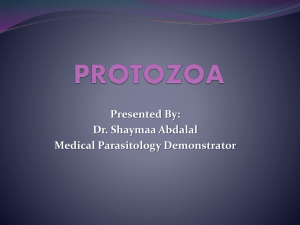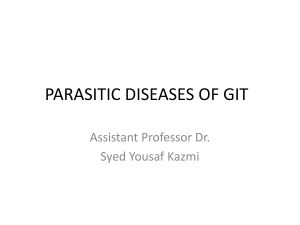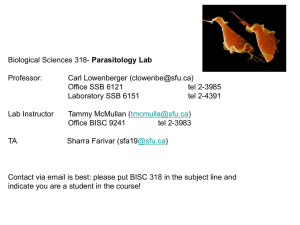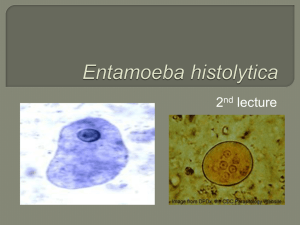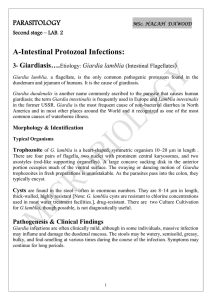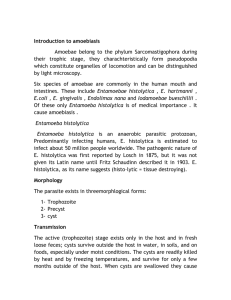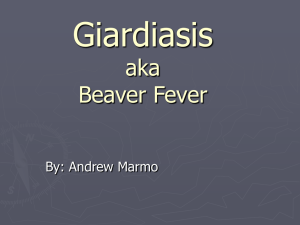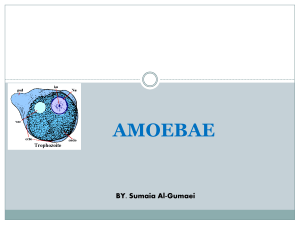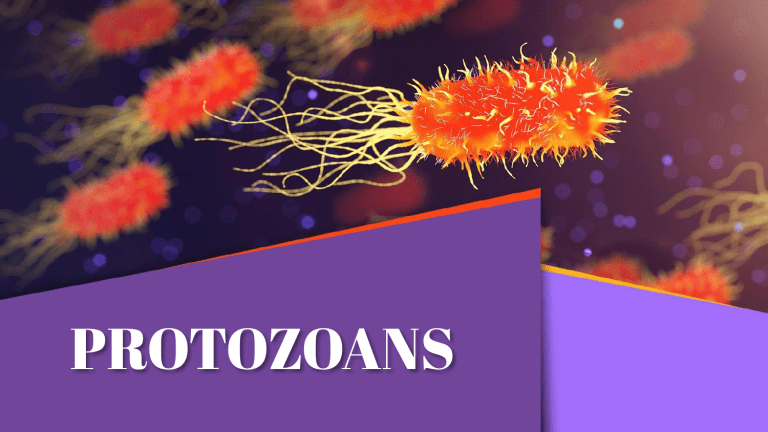
PROTOZOANS Outline • • • • • Classifications of Parasitic Protozoans Amoeba (Entamoeba histolytica) Ciliate (Balantidium coli) Flagellates (Giardia lamblia) Coccidia (Toxoplasma gondii) Classifications Amoebae • Move by pseudopodia Ciliates • Move by cilia Flagellates • Move by flagella Coccidia • Lack organelles for locomotion Classifications Amoebae Ciliate Flagellate Coccidia Amoebae Unicellular Asexual reproduction • Binary fission Free living Amoebae Genus: Entamoeba Parasites of alimentary tract – man, monkeys, vertebrates and invertebrates Amoebae Characteristics of this genus: ✔ Nucleus more or less spherical ✔ Nuclear membrane line with chromatin granules ✔ Small karyosome situated at or near thecenter ✔ Trophozoite has single nucleus Amoebae Amoebae that parasitize humans Entamoeba histolytica E.dispar E.coli E.hartmani Endolimax nana Iodamoeba butschlii Dientamoeba fragillis Entamoeba gingivalis Stages Stage 1 Trophozoite • Motile and feeding stage • Binary fission Stage 2 Cyst • Inactive • Non-motile • Infective Stages Amoebae AMOEBAE ENTAMOEBA HISTOLYTICA ENTAMOEBA HISTOLYTICA Worldwide incidence: 0.2-50% Highest prevalence in areas with poor sanitation No animal reservoirs Estimated 50 million cases/year and 100, 000 deaths/year ENTAMOEBA HISTOLYTICA • Disease: amoebiasis • Blood and mucous diarrhea ENTAMOEBA HISTOLYTICA Stage 1 Trophozoite Stage • Size: 20-40 μm • Motility: active, directional • Pseudopodia: finger-like, hyaline, very rapidly extruded • Inclusions: RBCs (invasive forms) • Nucleus: single, fine central kayosome, regular peripheral chromatin ENTAMOEBA HISTOLYTICA ENTAMOEBA HISTOLYTICA Stage 2 Cyst Stage • Size: 10-20 μm, spherical • Nuclei: 1-4, structure like trophozoite • Chromatoid bodies: thick, 1-2 stain like chromatin, disappear as cyst matures ENTAMOEBA HISTOLYTICA Infection with E. histolytica DOES NOT necessarily lead to disease. The outcome depends on host and parasite factors. CILIATES BALANTIDIUM COLI Ciliates Feed on particulate food, small bacteria or large organisms Has cilia Have 2 kinds of nuclei: macronuclei and micronuclei Free-living; few are commensals or parasitic BALANTIDIUM COLI • Only ciliated protozoan pathogenic in humans • Largest protozoan infecting humans • Primarily a zoonotic intestinal parasite (pigs) BALANTIDIUM COLI Final Host • Humans Reservoir Host • Pigs (zoonotic) Habitat • Cecum and colon Transmission • Fecal-oral route and pigs appear to be the source of most human cases General Distribution • Cosmopolitan and can be found wherever pigs are found BALANTIDIUM COLI Disease: Balantidiasis or balantidial dysentery BALANTIDIUM COLI Stage 1 Trophozoite • Shape/Size: Oval, 50-100 µm long by 40-70 µm wide • Anterior funnel shaped cystosome is usually visible • Posterior end is an excretory opening termed as cytopyge • Short cilia cover the cell surface • Internally, a horse-shoe or sausage-shaped or kidney shaped macronucleus is prominent • Adjacent round micronucleus is not BALANTIDIUM COLI Stage 2 Cyst • Formed as feces dehydrate in the colon or rectum • Shape/Size: Slightly ovoid and have a diameter of 45-65 µm • Presence of cyst wall and cilia are absent • Macronucleus is prominent, micronucleus may not be FLAGELLATES GIARDIA LAMBLIA Flagellates Inhabit the reproductive tract, alimentary canal, tissue sites and also the blood stream, lymph vessels and cerebrospinal canal Cystosome may be present, has more than 1 flagellum Can swim invading to a wider range of environments unsuitable for other protozoans GIARDIA LAMBLIA Also “Giardia duodenalis” Most common flagellate of the intestinal tract One of the most common cause of infectious diarrhea throughout the world Geographical Distribution: Worldwide (tropical and subtropical region) More common in warm climates Reservoir: Humans GIARDIA LAMBLIA Disease: Giardiasis, “traveler’s diarrhea” , “beaver fever” GIARDIA LAMBLIA Stage 1 Trophozoite • Pear or pyriform shaped • Found in diarrheic stool • Rounded anteriorly and pointed posteriorly • Bilaterally symmetrical • Size: 9-20 μm L x 5-15 μm W • Divide by binary fission GIARDIA LAMBLIA Stage 1 Trophozoite • Sucking disc occupying ½ -3/4 of the ventral surface (used for attachment of jejunal or duodenal mucosa) • 4 pairs of lateral flagella, 2 ventral and 2 caudal (enhance falling leaf movement) • 2 oval-shaped nuclei with large central karyosome on each side near the anterior end GIARDIA LAMBLIA Stage 2 Cyst • Ovoidal/ellipsoidal-shaped thick wall • Size: 8-12 μm L x 7-10 μm • Contains 2-4 nuclei located at one end axoneme, parabasal bodies and other remnant organelles of the trophozoite • Habitat: duodenum and jejunum • Mature cyst is the infective stage, at least 10 cysts are required to cause infection GIARDIA LAMBLIA COCCIDIA TOXOPLASMA GONDII Coccidia Feed on particulate food, small bacteria; others feed on large organisms Possess simple cilia during some part of their life cycle Mostly free-living, some are commensals or parasitic TOXOPLASMA GONDII Worldwide Zoonotic parasite, opportunistic pathogen • Infects animals, cattle, birds, rodents, pigs, sheep and humans Disease: Toxoplasmosis • Leading cause of abortion in sheep and goats Intracellular parasite Final Host: Felidae family, cat Intermediate Host: Mammals TOXOPLASMA GONDII Disease: Toxoplasmosis • All parasite stages are infectious • Risk groups: pregnant women, meat handlers (food preparation) or anyone who eats raw meat TOXOPLASMA GONDII Cats (Mainly domestic and wild cats) Definitive (final) host. Domestic cats, who pick up the organism from eating infected rodents Asexual and sexual division is intracellular Oocytes in feces TOXOPLASMA GONDII Humans (Mammals) Intermediate host Asexual tissue cycle Motile, disease producing phase = tachyzoites Non-motile “slow” phase in tissue cyst = bradyzoites TOXOPLASMA GONDII Stage 1 Oocysts in the Feces of Cat • Cat ingests tissue cysts containing bradyzoites. • Gametocytes develop in the small intestine. • Sexual cycle produces the oocyst which is excreted in the faces. • Oocysts appear in the cat’s feces 3-5 days after infection by cysts. • Require oxygen and they sporulate in 1-5 days TOXOPLASMA GONDII Stage 2 Bradyzoites • Slow growing stage inside the tissue cysts. • Mark the chronic phase of infection • Resistant to low pH and digestive enzymes during stomach passage. • Protective cyst wall is finally dissolved and infect tissue and transform into tachyzoites. • Released in the intestine and are highly infective if ingested TOXOPLASMA GONDII Stage 3 Tachyzoite Stage • Rapidly growing stage observed in the early stage of infection • Acute phase habits in the body fluid • Crescent-shaped. One end is more pointed than the other subterminal placed nucleus. • Asexual form. • multiplies by endodyogeny. • It can infect phagocytic and non-phagocytic cells TOXOPLASMA GONDII References Schuster, FL. and Ramirez-Avila, L. Current World Status of Balantidium coli. (2008). Clin. Mic. Rev. 21(4): 626–638. Schmidt GD, & Roberts LS. (2005). Foundations of Parasitology. 7th ed. McGraw Hill. Boston. http://www.cdfound.to.it/html/bal1.htm http://www.dpd.cdc.gov/dpdx/HTML/Balantidiasis.ht http://www.stanford.edu/group/parasites/ParaSites2006/ http://www.tntech.edu/wrc/119.htm http://parasitewonders.blogspot.com/2009_10_0 _archive.htm http://pathmicro.med.sc.edu/parasitology/intest-protozoa.htm http://www.umanitoba.ca/science/zoology/faculty/dick/z346/balanhome.html http://www.ufrgs.br/parasito/dinamica/parasitos/protozoa/ciliophora/balantidi um/balantidium.html http://www.kstate.edu/parasitology/625tutorials/Ciliates.html http://www.stanford.edu/group/parasites/ParaSites2003/Balantidium/Animal_ Reservoir.htm http://en.wikipedia.org/wiki/Giardia_lamblia http://www.phsource.us/PH/PARA/Chapter_3. htm http://en.wikipedia.org/wiki/Flagellate
